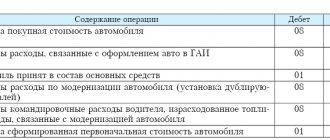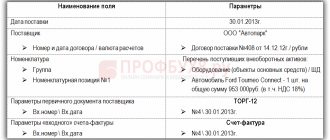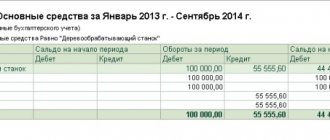Paragraph 2 of Article 257 of the Tax Code determines that the initial cost of fixed assets can be changed only in cases strictly defined by the specified norm. Namely in cases:
- completions;
- retrofitting;
- reconstruction;
- modernization;
- technical re-equipment;
- partial liquidation;
- and for other reasons.
Let us define what each of the definitions used means. Paragraph 2 of Article 257 of the Tax Code notes that work on completion, additional equipment, and modernization includes work caused by changes in technological or service equipment, a building, structure or other object of depreciable fixed assets, increased loads or other new qualities.
For the purposes of Chapter 25 of the Tax Code, the reconstruction of fixed assets means the reconstruction of existing fixed assets associated with improving production and increasing its technical and economic indicators. At the same time, the reconstruction of fixed assets should be carried out according to the project and in order to increase production capacity, improve quality and change the product range.
Technical re-equipment includes a set of measures to improve the technical and economic indicators of fixed assets or their individual parts based on the introduction of advanced equipment and technology, mechanization and automation of production, modernization and replacement of obsolete and physically worn-out equipment with new, more productive ones.
From the definitions we conclude that the main purpose of carrying out this work (modernization or reconstruction) is to improve or increase the initially adopted standard indicators of the functioning of fixed assets or to change the purpose of use of the object.
However, in practice there are often situations when, for example, reconstruction seems quite difficult to distinguish from major repairs. What should an accountant do in such a situation? And what documents need to be used to determine that reconstruction or repair has been carried out. Let's look at this in more detail.
Important point
The initial cost of fixed assets changes in cases of completion, additional equipment, reconstruction, modernization, technical re-equipment, partial liquidation of relevant facilities and on other similar grounds
What's all the fuss about?
It would seem, why such a distinction? And what difference does it make whether reconstruction or major repairs are carried out? The answer is simple, like everything ingenious - in accounting. In tax accounting, repair costs are taken into account as a lump sum in the amount of actual costs. Provided that the organization does not have a reserve for the repair of fixed assets (clause 2, clause 1, article 253 of the Tax Code of the Russian Federation, clause 1, article 260 of the Tax Code of the Russian Federation, clause 5, article 272 of the Tax Code of the Russian Federation).
As for reconstruction, the accounting is somewhat different. Such expenses increase the initial cost of fixed assets, which in the future can only be written off through depreciation charges (Articles 256-259 of the Tax Code of the Russian Federation). Naturally, such a write-off is extremely unprofitable for business entities, since accounting for costs in income tax expenses extends over many years.
It is also necessary to remember that the calculation of depreciation of fixed assets after reconstruction in accounting and tax accounting differs and the application of PBU 18/02 “Accounting for income tax expenses” (approved by Order of the Ministry of Finance of the Russian Federation of November 19, 2002 No. 114n) is inevitable.
From the above, it is clear that the accountant needs to clearly distinguish between when repairs were carried out and when reconstruction was carried out. Note that in the first case, only the shortcomings and errors formed during the work are eliminated in the object, and during reconstruction the properties of the object are improved. Of course, it is beneficial for the company to write off costs at a time and treat them as repairs. However, it is absolutely certain that the tax authorities will not agree with this. And in every convenient case they will assume that reconstruction was carried out and charge income tax with all the ensuing consequences.
FSBU and IFRS: almost an equal sign
Paragraph 15 of FAS 6/2020 states that “when assessing fixed assets at a revalued cost, the value of the fixed asset is regularly revalued so that it is equal to or does not differ significantly from their fair value. [At the same time] For the purposes of this Standard, fair value is determined in the manner prescribed by International Financial Reporting Standard (IFRS) 13 “Fair Value Measurement”, put into effect on the territory of the Russian Federation by Order of the Ministry of Finance of the Russian Federation dated December 28, 2015 No. 217n ( registered by the Ministry of Justice of the Russian Federation on February 2, 2021, registration No. 40940).
According to paragraph 17 of FAS 6/2020, “revaluation of... fixed assets is carried out by recalculating their original cost and accumulated depreciation so that the book value of the fixed asset item after revaluation is equal to its fair value. It is also acceptable to carry out a revaluation of fixed assets, in which first the original cost of an item of fixed assets is reduced by the amount of depreciation accumulated on it on the date of revaluation, and then the resulting amount is recalculated so that it becomes equal to the fair value of this item of fixed assets.”
These provisions also develop the requirements defined in paragraph 38 of FAS 6/2020, according to which “the organization checks [must check - M.P.] fixed assets for impairment and takes into account the change in their carrying value due to impairment in the manner prescribed by the International Financial Reporting Standard (IAS ) 36 “Impairment of assets”, put into effect on the territory of the Russian Federation by order of the Ministry of Finance of the Russian Federation dated December 28, 2015 No. 217n (registered by the Ministry of Justice of the Russian Federation on February 2, 2021, registration No. 40940).
Compensation for losses associated with the depreciation or loss of an item of fixed assets provided to the organization by other persons is recognized as income in the profit (loss) of the period in which the organization has the right to receive such compensation.”
Other definitions of reconstruction
Not only does it seem quite difficult to distinguish between the types of construction and installation work being carried out, it is also necessary to use legislation that has been in force since the times of the Soviet Union and branches of law other than tax law.
Let us note that the Tax Code provides too general a definition and in practice it seems quite difficult to classify exactly what types of construction and installation work were performed.
Typically, accountants use Appendix 1 to Departmental Construction Standards VSN 58-88 (r) “Regulations on the organization and conduct of reconstruction, repair and maintenance of buildings, public utility and social-cultural facilities” (approved by the Order of the State Committee for Architecture of the Russian Federation under the USSR State Construction Committee dated November 23 1988, hereinafter referred to as Appendix 1 to the BSN).
Appendix 1 to the BSN notes that the reconstruction of a building is a complex of construction work and organizational and technical measures associated with changes in the main technical and economic indicators. For example, the number and area of apartments, construction volume and total area of the building, capacity and throughput or its purpose in order to improve living conditions, quality of service, increase the volume of services.
Definitions of reconstruction can also be found in letter of the USSR Ministry of Finance dated May 29, 1984 No. 80, Methodology for determining the cost of construction products on the territory of the Russian Federation MDS 81-35.2004 (approved by Resolution of the State Committee for Construction of Russia dated March 5, 2004 15/1), letter of the State Planning Committee USSR No. NB-36-D, letter of the USSR State Construction Committee No. 23-D, USSR Stroybank No. 144, USSR Central Administration No. 6-14 dated May 8, 1984 “On the definition of the concepts of new construction, expansion, reconstruction and technical re-equipment of operations
The Law of July 18, 2011 No. 215-FZ “On Amendments to the Town Planning Code and Certain Legislative Acts of the Russian Federation” (with the exception of certain provisions) (hereinafter referred to as Law No. 215-FZ) brought a lot of clarity. These amendments introduced and supplemented the legislative acts of the Russian Federation. First of all, the innovations affected the Town Planning Code. The legislator has significantly supplemented the existing definition of reconstruction.
Thus, from July 22, 2011, you can use a new, more expanded interpretation of the definition of “reconstruction”, as well as the types of work that can be classified as it. The “new” edition contains definitions of reconstruction for capital construction projects, linear objects (communication or power lines, pipelines, roads, etc.). In addition to changing the parameters of an object, such as height, number of storeys, volume area, reconstruction also includes such types of work as: superstructure, reconstruction or expansion of an object, replacement or restoration of its load-bearing building structures, with the exception of individual elements of these structures with similar ones or other improving indicators.
There is no definition of “repair” in either tax or accounting legislation. Therefore, let us turn again to construction regulations. In the letter of the State Statistics Committee of Russia dated April 9, 2001 No. MS-1-23/1480 there is the following definition: the cost of repairs (current, medium and capital) means the cost of work to maintain fixed assets (their individual parts and structures) in working condition during their useful life, which does not lead to an improvement in the initial standard performance indicators.
In paragraph 3.1 of the Regulations on carrying out planned preventative repairs of industrial buildings and structures MDS 13-14.2000 (approved by the resolution of the USSR State Construction Committee dated December 29, 1973 No. 279) there is another definition of “repair”, defining it as a set of technical measures aimed at maintaining or restoration of the original operational qualities of both the building or structure as a whole and their individual structures. Repairs are usually divided into current and major. Law No. 215 - Federal Law made its “mite” in the definition of “repair”. So a major overhaul is the replacement or restoration of:
- building structures of capital construction projects or replacement of their elements (except load-bearing ones);
- engineering support systems and their networks;
- individual elements of load-bearing building structures for similar or other improving indicators.
Revaluation of fixed assets
In the process of using OS in enterprises, sometimes there is a need to bring the initial cost to the market value. To do this, a revaluation of objects is carried out, as a result, an additional valuation or depreciation occurs, and further accounting is carried out at the new price received.
In what cases may it be necessary to re-evaluate the operating system:
- To increase the authorized capital budget.
- If there is a need for a loan secured by fixed assets.
- To obtain the actual cost of finished products, goods sold, work or services provided.
- If it is necessary to attract new investments.
- In case of enterprise reform.
- Before selling assets.
To carry out revaluation, certain rules must be followed:
- The current value of the fixed assets is restored to the confirmed market price through direct accrual or indexation.
- Revaluation cannot be done once. Having done it once, the company will be forced to carry it out constantly.
- It is carried out once a year at the end of the reporting period. All OS objects included in the group fall under it.
What data is needed to properly reassess the OS:
- The initial cost of accepting fixed assets on the balance sheet of the enterprise or its current price, if revaluation has already been carried out previously, according to accounting data as of the last month of the year.
- The amount of depreciation accrued for the entire period of use of the operating system according to accounting data as of the last month of the year.
- Documentary data on the recoverable current value of fixed assets on the market as of the last month of the year.
Revaluation of assets
To accurately determine the market value, you can use the data of manufacturers of similar objects, take prices from trade inspectorates or statistical authorities, and also rely on prices presented in the media.
To carry out a revaluation, the company issues an order or order, which lists all employees participating in the procedure. The document must be certified by the head of the organization, and it must contain signatures of all participants.
After the order is ready, it is necessary to draw up an accurate list of all objects subject to revaluation. What information needs to be provided:
- Exact name.
- Date of acquisition, manufacture or construction of the OS.
- The date when the fixed assets were accepted onto the balance sheet of the enterprise.
Based on the results, a report is drawn up indicating new prices. All documents on the basis of which the operation was carried out must be attached.
The revaluation of fixed assets is not reflected in tax accounting in any way, so there will be a permanent difference between accounting and tax data.
If, after additional valuation of fixed assets, the amount reflected in the accounting records becomes greater than in the tax records, a PNO (permanent tax liability) arises. To write off the difference between depreciation amounts, you should make the following entry in accounting:
Dt 99 subaccount “Fixed tax liabilities (assets)” Kt 68 subaccount “Calculations for income tax”.
If, as a result of revaluation, the value of fixed assets was depreciated, a PTA (permanent tax asset) arises. To write off the difference you need to make the following entry:
Dt 68 subaccount “Calculations for income tax” Kt 99 subaccount “Fixed tax liabilities (assets)”.
Important! The initial cost of an asset does not include the amount of VAT. An exception is made for organizations that are not VAT payers. They can include this amount in the price in accordance with Article 170 of the Tax Code of the Russian Federation.
Fundamental differences
The main difference between repair and reconstruction is that the purpose of the former is preventive measures, the elimination of minor damage and malfunctions in order to protect and premature wear of fixed assets. As a result of any repair, the purpose of the fixed asset object, its technical and economic indicators, technological or service purpose do not change, product quality does not improve, and production space does not increase.
The purpose of the reconstruction is to improve the initially adopted standard indicators of the functioning of the fixed asset object, to increase the capacity and useful life.
Thus, when distinguishing between the reconstruction and repair of fixed assets, the change in technical and economic indicators, technological or service purpose, and the acquisition of new qualities play a decisive role. This conclusion is confirmed by letters from the Ministry of Finance of Russia dated April 22, 2010 No. 03-03-06/1/289, dated March 24, 2010 No. 03-03-06/4/29.
Important point
The cost of the work performed cannot be a determining factor for distinguishing between repair and reconstruction. Letter of the Ministry of Finance of Russia dated March 24, 2010 No. 03-03-06/4/29.
Arbitrage practice
The judges, taking into account these definitions, in their decisions come to the conclusion that repair work includes work that does not change the technological or service purpose of fixed assets, does not improve production and does not increase its technical and economic indicators. For example, this position is adhered to in the resolution of the Federal Antimonopoly Service of the Moscow District dated June 8, 2011 No. KA-A40/5373-11. In their decision, the arbitrators indicate that when qualifying the work performed for the purpose of classifying expenses as repair or modernization, it is necessary to proceed from the purpose and focus of such work, taking into account that repair (costs that do not increase the inventory value of the facility) include such types of work , after which the object’s performance does not improve (increase). The purpose of repair is to eliminate existing faults, the presence of which makes the operation of the fixed asset dangerous (impossible). A similar position is expressed in decisions of the FAS North-Western District dated August 30, 2010 No. A56-35754/2009, FAS North Caucasus District dated June 24, 2011 No. A53-18544/2010, FAS Moscow District dated May 11, 2011 No. KA-A41/3691-11.
Replacement of individual failed elements of a fixed asset, not associated with a change in the technological or service purpose of the equipment, or a change in its technical and economic indicators, is not modernization and is considered as a repair of a fixed asset (letter of the Ministry of Finance of the Russian Federation dated August 3, 2010 No. 03-03 -06/1/518). A similar point of view is expressed in the Resolution of the Federal Antimonopoly Service of the Volga Region dated May 17, 2011 No. A65-20282/2010).
Transitional provisions
The consequences of changes in the accounting policies of an organization in connection with the start of application of FAS 6/2020 are reflected retrospectively, that is, as if this standard had been applied from the moment the facts of economic life affected by it arose.
To facilitate the transition to the new procedure for accounting for fixed assets in accounting, starting from which FAS 6/2020 is applied, the organization may not recalculate comparative indicators related to fixed assets for periods preceding the reporting one, making a one-time adjustment to the book value of fixed assets at the beginning of the reporting period (end of the period, preceding the reporting one).
For the purposes of this adjustment, the carrying value of fixed assets is considered to be their original cost (taking into account revaluations), recognized before the application of FAS 6/2020 in accordance with the previously applied accounting policy, less accumulated depreciation.
Source:
"Clerk"
Heading:
Fixed assets
fixed assets FSBU 6/2020 depreciation of fixed assets
- Inna Kosnova, Clerk columnist, accounting and taxation expert
Sign up 8645
12350 ₽
–30%
Supreme Court Opinion
An interesting position is taken by the judges in the Resolution of the Presidium of the Supreme Arbitration Court of the Russian Federation dated February 1, 2011 No. 11495/10. In the said ruling, the arbitrators note that the same work can be qualified as both a major overhaul and a reconstruction. The tax authority qualified the work of cutting out part of the production string intended to lift oil from the bottom to the wellhead and drilling a sidetrack from this place as reconstruction, since as a result of the measures taken, oil production increased. However, the company took them into account in the taxable base as major repairs. The judges in their decision indicated that an increase in oil production in itself is not a sufficient criterion for qualifying the work mentioned as a major overhaul or reconstruction. And it is necessary to classify the type of work performed as repair or reconstruction based on the condition of the well. Thus, drilling sidetracks in idle wells refers to reconstruction. But work carried out in technically faulty wells or due to the extreme water cut of the formations resulting from the breakthrough of formation waters must be recognized as a major overhaul.
Accounting
A change in the initial cost of fixed assets, in which they are accepted for accounting, is allowed in cases of completion, additional equipment, reconstruction, modernization, partial liquidation (clause 14 of PBU “Accounting for fixed assets 6/01”, approved by Order of the Ministry of Finance of Russia dated March 30, 2001 No. 26n, hereinafter referred to as PBU 6/01).
Upon completion of work on the completion, additional equipment, reconstruction, modernization of a fixed asset item, the costs recorded in the account for investments in non-current assets either increase the initial cost of this fixed asset item and are written off as a debit to the fixed asset account, or are recorded separately in the fixed asset account , and in this case, a separate inventory card is opened for the amount of expenses incurred (clause 42 of the “Methodological guidelines for accounting of fixed assets”, approved by Order of the Ministry of Finance of Russia dated October 13, 2003 No. 91n, hereinafter referred to as the Guidelines).
The costs of such work are recorded on account “08” “Investments in non-current assets”. Upon completion of the work performed, they must be written off from the credit of account “08” “Investments in non-current assets” to the debit of account “01” “Fixed assets” (clause 42 of the Methodological Instructions, Instructions for using the chart of accounts). In connection with the modernization, reconstruction, completion or additional equipment, the useful life of the facility may be changed (clause 20 of PBU 6/01).
Depreciation for the reconstructed facility will be accrued from the first day of the month following the month of completion of all reconstruction work (clause 21 of PBU 6/01, clause 4 of Article 259 of the Tax Code of the Russian Federation).
note
When carrying out repairs, you need to draw up a defect report.
Damping elements
FSBU 6/2020 introduces the concept of “depreciation elements”. Paragraph 37 of FSBU 6/2020 establishes that “the useful life, salvage value and method of calculating depreciation (hereinafter referred to as depreciation elements) of an item of fixed assets are determined upon recognition of this item in accounting.”
“Elements of depreciation of a fixed asset,” says FSBU 6/2020, “are subject to verification for compliance with the conditions of use of the fixed asset. Such a check is carried out at the end of each reporting year, as well as upon the occurrence of circumstances indicating a possible change in the elements of depreciation. Based on the results of such a check, if necessary, the organization decides to change the relevant elements of depreciation. The adjustments that arise in connection with this are reflected in accounting as changes in estimated values.”






